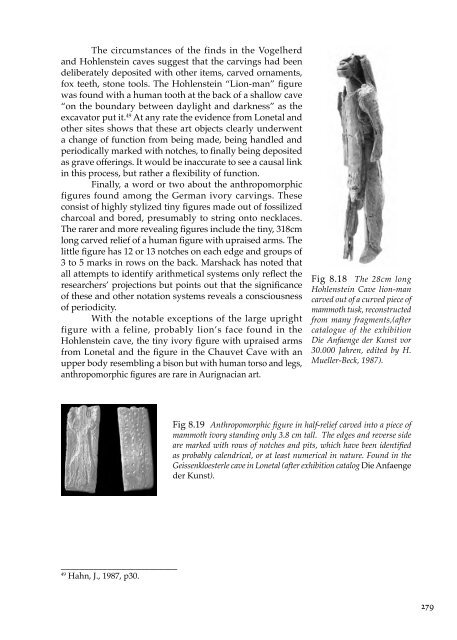The Spirit in Human Evolution - Waldorf Research Institute
The Spirit in Human Evolution - Waldorf Research Institute
The Spirit in Human Evolution - Waldorf Research Institute
You also want an ePaper? Increase the reach of your titles
YUMPU automatically turns print PDFs into web optimized ePapers that Google loves.
<strong>The</strong> circumstances of the f<strong>in</strong>ds <strong>in</strong> the Vogelherd<br />
and Hohlenste<strong>in</strong> caves suggest that the carv<strong>in</strong>gs had been<br />
deliberately deposited with other items, carved ornaments,<br />
fox teeth, stone tools. <strong>The</strong> Hohlenste<strong>in</strong> “Lion-man” figure<br />
was found with a human tooth at the back of a shallow cave<br />
“on the boundary between daylight and darkness” as the<br />
excavator put it. 49 At any rate the evidence from Lonetal and<br />
other sites shows that these art objects clearly underwent<br />
a change of function from be<strong>in</strong>g made, be<strong>in</strong>g handled and<br />
periodically marked with notches, to f<strong>in</strong>ally be<strong>in</strong>g deposited<br />
as grave offer<strong>in</strong>gs. It would be <strong>in</strong>accurate to see a causal l<strong>in</strong>k<br />
<strong>in</strong> this process, but rather a flexibility of function.<br />
F<strong>in</strong>ally, a word or two about the anthropomorphic<br />
figures found among the German ivory carv<strong>in</strong>gs. <strong>The</strong>se<br />
consist of highly stylized t<strong>in</strong>y figures made out of fossilized<br />
charcoal and bored, presumably to str<strong>in</strong>g onto necklaces.<br />
<strong>The</strong> rarer and more reveal<strong>in</strong>g figures <strong>in</strong>clude the t<strong>in</strong>y, 318cm<br />
long carved relief of a human figure with upraised arms. <strong>The</strong><br />
little figure has 12 or 13 notches on each edge and groups of<br />
3 to 5 marks <strong>in</strong> rows on the back. Marshack has noted that<br />
all attempts to identify arithmetical systems only reflect the<br />
researchers’ projections but po<strong>in</strong>ts out that the significance<br />
of these and other notation systems reveals a consciousness<br />
of periodicity.<br />
With the notable exceptions of the large upright<br />
figure with a fel<strong>in</strong>e, probably lion’s face found <strong>in</strong> the<br />
Hohlenste<strong>in</strong> cave, the t<strong>in</strong>y ivory figure with upraised arms<br />
from Lonetal and the figure <strong>in</strong> the Chauvet Cave with an<br />
upper body resembl<strong>in</strong>g a bison but with human torso and legs,<br />
anthropomorphic figures are rare <strong>in</strong> Aurignacian art.<br />
Fig 8.18 <strong>The</strong> 28cm long<br />
Hohlenste<strong>in</strong> Cave lion-man<br />
carved out of a curved piece of<br />
mammoth tusk, reconstructed<br />
from many fragments,(after<br />
catalogue of the exhibition<br />
Die Anfaenge der Kunst vor<br />
30.000 Jahren, edited by H.<br />
Mueller-Beck, 1987).<br />
Fig 8.19 Anthropomorphic figure <strong>in</strong> half-relief carved <strong>in</strong>to a piece of<br />
mammoth ivory stand<strong>in</strong>g only 3.8 cm tall. <strong>The</strong> edges and reverse side<br />
are marked with rows of notches and pits, which have been identified<br />
as probably calendrical, or at least numerical <strong>in</strong> nature. Found <strong>in</strong> the<br />
Geissenkloesterle cave <strong>in</strong> Lonetal (after exhibition catalog Die Anfaenge<br />
der Kunst).<br />
_________________________<br />
49<br />
Hahn, J., 1987, p30.<br />
279
















